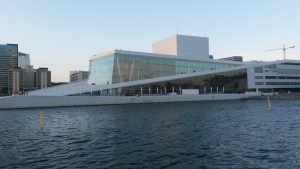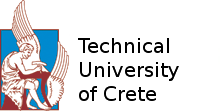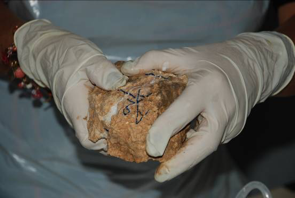Innovative materials and techniques for the conservation of 20th century concrete-based cultural heritage
The Oslo Opera House – Condition analysis and proposal for protection and maintenance of exterior marble
 First prize at the international contest “The Oslo Opera House – Condition analysis and proposal for protection and maintenance of exterior marble”, organized by Statsbygg, Norway, 2015. The Oslo Opera House is a listed building of approximately 23 000 m² Carrara Marble that decorates the external facades and roof of the Opera. In this project, Betong Consult AS, NanoPhos SA, the Laboratory Materials and Methods for Cultural Heritage of the Politecnico di Milano and the Surfa Products Scandinavia AS, also collaborate. TUC in collaboration with NanoPhos designed and implemented the cleaning agents in lab and industrial scale, respectively, aiming at the removal of the yellowing discoloration from the Carrrara marble tiles of the Opera.
First prize at the international contest “The Oslo Opera House – Condition analysis and proposal for protection and maintenance of exterior marble”, organized by Statsbygg, Norway, 2015. The Oslo Opera House is a listed building of approximately 23 000 m² Carrara Marble that decorates the external facades and roof of the Opera. In this project, Betong Consult AS, NanoPhos SA, the Laboratory Materials and Methods for Cultural Heritage of the Politecnico di Milano and the Surfa Products Scandinavia AS, also collaborate. TUC in collaboration with NanoPhos designed and implemented the cleaning agents in lab and industrial scale, respectively, aiming at the removal of the yellowing discoloration from the Carrrara marble tiles of the Opera.
Bioinspired nanocomposites for the strengthening of construction materials
“European Territorial Cooperation”, NSRF, Greek General Secretariat for Research and Technology (GRST). More information about the project are presented on the official website of the program: www.nanobiodomyl.gr
 This project involves the synthesis and evaluation of modified nanoparticle composite of tetraethoxysilane (TEOS) and nano-calcium oxalate in alcoholic nanoparticle suspension, aqueous nanoparticle suspension and dry nanoparticle powder. The application of these nanocomposites, which show compatibility with the mineral phases of traditional building materials, such as building blocks, bricks, tiles, cement and lime-mortar increased the resistance to weathering and corrosion. This project delivered the manufacture of products and their placing on the market from NanoPhos company named SurfaPore FX in alcohol and water based solvent.
This project involves the synthesis and evaluation of modified nanoparticle composite of tetraethoxysilane (TEOS) and nano-calcium oxalate in alcoholic nanoparticle suspension, aqueous nanoparticle suspension and dry nanoparticle powder. The application of these nanocomposites, which show compatibility with the mineral phases of traditional building materials, such as building blocks, bricks, tiles, cement and lime-mortar increased the resistance to weathering and corrosion. This project delivered the manufacture of products and their placing on the market from NanoPhos company named SurfaPore FX in alcohol and water based solvent.
“Modified tetraethoxysilane with nano-calcium oxalate in one-pot synthesis for protection of building materials” by Anastasia Verganelaki, Chrysi Kapridaki and Pagona Maravelaki-Kalaitzaki, Ind. Eng. Chem. Res., 54 (29), (2015), p. 7195-7206. 2015 American Chemical Society.
“A biomimetic approach to strengthen and protect construction materials with a novel calcium-oxalate–silica nanocomposite”, A Verganelaki, V Kilikoglou, I Karatasios, P Maravelaki-Kalaitzaki, Construction and Building Materials 62, 2014, pp. 8-17.
Kommos Archaeological Site / General Condition Assessment”,
American School of Classical Studies Institute for Aegean Prehistory Study Center for East Crete INSTAP-SCEC S.A. 2015-2016
 This research project assessed the condition of the exposed structures in the archaeological area of Kommos and suggesting a planned conservation program to protect and maintain the stone structures for the future. Into this framework particular attention devoted to a general assessment of the various structures of the site and the impact of the environmental conditions in the conservation state of the different construction elements. The scarp (excavation trench) wall stabilization treatments, as well as mortars compatible with the original ones and stones were considered and a holistic conservation treatment for this area was proposed enhancing its resistance to environmental loading.
This research project assessed the condition of the exposed structures in the archaeological area of Kommos and suggesting a planned conservation program to protect and maintain the stone structures for the future. Into this framework particular attention devoted to a general assessment of the various structures of the site and the impact of the environmental conditions in the conservation state of the different construction elements. The scarp (excavation trench) wall stabilization treatments, as well as mortars compatible with the original ones and stones were considered and a holistic conservation treatment for this area was proposed enhancing its resistance to environmental loading.
Evaluation of chemical compatibility and improvement of stone consolidants with nano-technology.
“HRAKLEITOS II”, the European Union-European Social Fund (ESF) & National Sources.
 The innovative nanomaterials developed combine self-cleaning, waterproofing and restore the consistency of the structure of the building materials. These nanomaterials showed a low carbon footprint in their composition, environmental friendliness and efficient application on substrates of both modern buildings and monuments. Specifically, we prepared a hybrid nanocomposite with anatase crystals produced at ambient conditions, thus enhancing the photocatalytic properties of the nanomaterial.
The innovative nanomaterials developed combine self-cleaning, waterproofing and restore the consistency of the structure of the building materials. These nanomaterials showed a low carbon footprint in their composition, environmental friendliness and efficient application on substrates of both modern buildings and monuments. Specifically, we prepared a hybrid nanocomposite with anatase crystals produced at ambient conditions, thus enhancing the photocatalytic properties of the nanomaterial.
 “Producing photoactive, transparent and hydrophobic SiO2/crystalline TiO2 nanocomposites at ambient conditions with application as self-cleaning coatings”, C Kapridaki, L Pinho, MJ Mosquera, P Maravelaki-Kalaitzaki, Applied Catalysis B: Environmental 156, 2014, pp. 416-427.
“Producing photoactive, transparent and hydrophobic SiO2/crystalline TiO2 nanocomposites at ambient conditions with application as self-cleaning coatings”, C Kapridaki, L Pinho, MJ Mosquera, P Maravelaki-Kalaitzaki, Applied Catalysis B: Environmental 156, 2014, pp. 416-427.
“TiO2–SiO2–PDMS nano-composite hydrophobic coating with self-cleaning properties for marble protection”, Kapridaki, C, & Maravelaki-Kalaitzaki, P., Progress in Organic Coatings, Volume 76, Issue 2-3, 2013, pp. 400–410.
Hydraulic mortars with nano-titania for the adhesion of porous architectural members of the Acropolis Monuments
“Investigation mortar for bonding of poros (from Piraeus Coast) architectural monuments of the Acropolis” Acropolis Restoration Committee (ESMA), 2009-2014.
 In this collaborative research project with the Acropolis Restoration Committee various mortars were designed, analysed and studied for the adhesion of adjoining fragments of the porous stone architectural members. 14 different bonding mortars were designed and evaluated, with the aim of formulating a complex system characterized by the highest compatibility, according to their physico-chemical and mechanical properties at curing time. The lab experiments was followed by the implementation study by the Conservation Section of the Acropolis Restoration Service which pertained to the in situ preparation of the adhesive mortars, to the projects of the Acropolis Restoration Service. The optimum mortar metakaolin, calcium hydroxide, nano-titania and fine carbonate sand. The nano-titania addition induced improved mechanical properties over time, when compared to the specimens without nano-titania, due to enhancement of carbonation and hydration of the mortar mixtures with nano-titania.
In this collaborative research project with the Acropolis Restoration Committee various mortars were designed, analysed and studied for the adhesion of adjoining fragments of the porous stone architectural members. 14 different bonding mortars were designed and evaluated, with the aim of formulating a complex system characterized by the highest compatibility, according to their physico-chemical and mechanical properties at curing time. The lab experiments was followed by the implementation study by the Conservation Section of the Acropolis Restoration Service which pertained to the in situ preparation of the adhesive mortars, to the projects of the Acropolis Restoration Service. The optimum mortar metakaolin, calcium hydroxide, nano-titania and fine carbonate sand. The nano-titania addition induced improved mechanical properties over time, when compared to the specimens without nano-titania, due to enhancement of carbonation and hydration of the mortar mixtures with nano-titania.
“Physico-chemical and Mechanical Characterization of Hydraulic Mortars Containing Nano-Titania for Restoration Applications”, Maravelaki-Kalaitzaki, P., Agioutantis, Z., Lionakis, E., Stavroulaki, M., & Perdikatsis, V., Cement and Concrete Composites, Volume 36, Issue 1, 2013, pp. 33-41.
“Improvement of properties of hydraulic mortars with addition of nano-titania”, N. Maravelaki, C. Kapridaki, E. Lionakis, A. Verganelaki, In Adhesives: Mechanical Properties, Technologies and Economic Importance, Chapter 4, Editor Dario Croccolo, Nova Science Publishers, Inc., 2014, pp. 79-93.
Design and application of compatible mortars for the restoration of the Firkas Fortress, Chania, Crete, Greece,
Ministry of Culture, 2015.
 Original mortars from the Firkas Fortress were analyzed aimed at identifying raw materials and traditional technology, in order to propose compatible materials to preserve the walls of the fortification of the fortress Firkas and the Genoese Tower. The design of the conservation mortars and plasters included an extensive evaluation of the physico-chemical and mechanical properties followed by their pilot application. The on-site synthesis and the pilot applications provided additional information on the workability and the decision making of the final coloration of mortars and plasters.
Original mortars from the Firkas Fortress were analyzed aimed at identifying raw materials and traditional technology, in order to propose compatible materials to preserve the walls of the fortification of the fortress Firkas and the Genoese Tower. The design of the conservation mortars and plasters included an extensive evaluation of the physico-chemical and mechanical properties followed by their pilot application. The on-site synthesis and the pilot applications provided additional information on the workability and the decision making of the final coloration of mortars and plasters.
Venetian port of Chania: characterization and durability evaluation of pavement stones originating from Etna and Rhodes
Municipality of Chania, Port Authority of Chania, 2014
 The composition, the physicochemical and mechanical properties, of three different types of rocks have been studied and compared with one already existed in the Old Port of Chania in order to be used for the conservation and restoration of the pavement of the Old Venetian port. The stones are of Italian (Etna) and Greek (Rhodes) origin. It has been demonstrated that the volcanic stones originating from Etna resisted better to mechanical and sea salt loading than the quarzitic sandstone with calcite as binder, from Rhodes.
The composition, the physicochemical and mechanical properties, of three different types of rocks have been studied and compared with one already existed in the Old Port of Chania in order to be used for the conservation and restoration of the pavement of the Old Venetian port. The stones are of Italian (Etna) and Greek (Rhodes) origin. It has been demonstrated that the volcanic stones originating from Etna resisted better to mechanical and sea salt loading than the quarzitic sandstone with calcite as binder, from Rhodes.
Characterization and durability evaluation of commercial eco-lime mortars and plasters
“SA NE DEVETZOGLOU ”, 2014
 Commercial eco lime mortars and plasters are nowadays available for conservation, restoration and renovation works in historic and modern masonry. However, understanding the physico-chemical and mechanical properties of these eco materials is of the main objectives of this study. Because of their chemical stability and the resistance against moisture, mold and sea-salt weathering these compatible materials were established as a trusted solution for application in traditional and modern buildings.
Commercial eco lime mortars and plasters are nowadays available for conservation, restoration and renovation works in historic and modern masonry. However, understanding the physico-chemical and mechanical properties of these eco materials is of the main objectives of this study. Because of their chemical stability and the resistance against moisture, mold and sea-salt weathering these compatible materials were established as a trusted solution for application in traditional and modern buildings.
Characterization of mortars originating from excavations in the Chania, Crete, dating from the Minoan to Hellenistic and Roman period.
Greek Ministry of Culture, 2010-2015
 Mortars were analyzed with regard to mineralogical and chemical composition, grain size distribution and hydraulic properties in order to gain insight into the provenance of the raw materials and mortar manufacturing technology. This study aimed also at discriminating different construction and chronological phases of the Hellenistic Fortifications in Chania. Comparison between mortars with known dating provided invaluable information on the architectural and historic phases of this monument.
Mortars were analyzed with regard to mineralogical and chemical composition, grain size distribution and hydraulic properties in order to gain insight into the provenance of the raw materials and mortar manufacturing technology. This study aimed also at discriminating different construction and chronological phases of the Hellenistic Fortifications in Chania. Comparison between mortars with known dating provided invaluable information on the architectural and historic phases of this monument.
Physicochemical analysis as a tool for mortar dating, N. Maravelaki, M. Andreadaki-Vlazaki, N. Kallithrakas-Kontos, K. Kalafata, 11th International Cretological Congress (Rethymnon, 21st-27th October 2011.
Characterization of mortars from the ancient city of Polyrrhenia, Chania, Crete
Greek Ministry of Culture, 2012
 This study focuses on the petrographic and mineralogical characterization of mortars originating from the Fortifications, the Roman aqueduct and the ruins of the acropolis of the Hellenistic – Roman archaeological site of Polyrrhenia Combining the petrographic data with the physico-chemical characterization several inconsistencies and uncertainties on the sequence of the construction phases were resolved.
This study focuses on the petrographic and mineralogical characterization of mortars originating from the Fortifications, the Roman aqueduct and the ruins of the acropolis of the Hellenistic – Roman archaeological site of Polyrrhenia Combining the petrographic data with the physico-chemical characterization several inconsistencies and uncertainties on the sequence of the construction phases were resolved.
Conservation plasters for the Catholic of the Monastery of St. Paul, Mount Athos
Monastery of Saint Paul, 2014
 Plasters of the Catholic St. Paul’s Monastery were characterized aiming at proposing coatings compatible with the original ones. The construction of the Catholic began in 1839 and was completed in 1844. Based on the results of the analyzed samples compatible conservation plasters were proposed exhibiting highest weathering resistance.
Plasters of the Catholic St. Paul’s Monastery were characterized aiming at proposing coatings compatible with the original ones. The construction of the Catholic began in 1839 and was completed in 1844. Based on the results of the analyzed samples compatible conservation plasters were proposed exhibiting highest weathering resistance.
Frangokastello Sfakià: Restoration and conservation through compatible architectural, structural and construction materials
Prefecture of Crete, 2014-2015
 The construction materials of the Castle have been severely deteriorated by the marine spray action and inappropriate restoration and conservation interventions. Mortars originating from the inner parts of the construction gave evidence on the historic mortar employed and the design of the conservation mortar was carried out accordingly. Emphasis was given on the analysis of original plasters maintained in limited areas of ornamental elements of the Castle; plasters compatible to the original ones were designed paying particular attention to enhance their resistance to the environmental loading.
The construction materials of the Castle have been severely deteriorated by the marine spray action and inappropriate restoration and conservation interventions. Mortars originating from the inner parts of the construction gave evidence on the historic mortar employed and the design of the conservation mortar was carried out accordingly. Emphasis was given on the analysis of original plasters maintained in limited areas of ornamental elements of the Castle; plasters compatible to the original ones were designed paying particular attention to enhance their resistance to the environmental loading.
Skoutelis Nikos, Stavroulaki Maria, Maravelaki Noni, Drosopoulos Georgios, Stavroulakis Georgios, Frangokastello Sfakià: Restoration and conservation through compatible architectural, structural and construction materials, International Scientific Conference, “Preservation of Cultural Heritage” BASA’ 2016, Sofia 2016.


